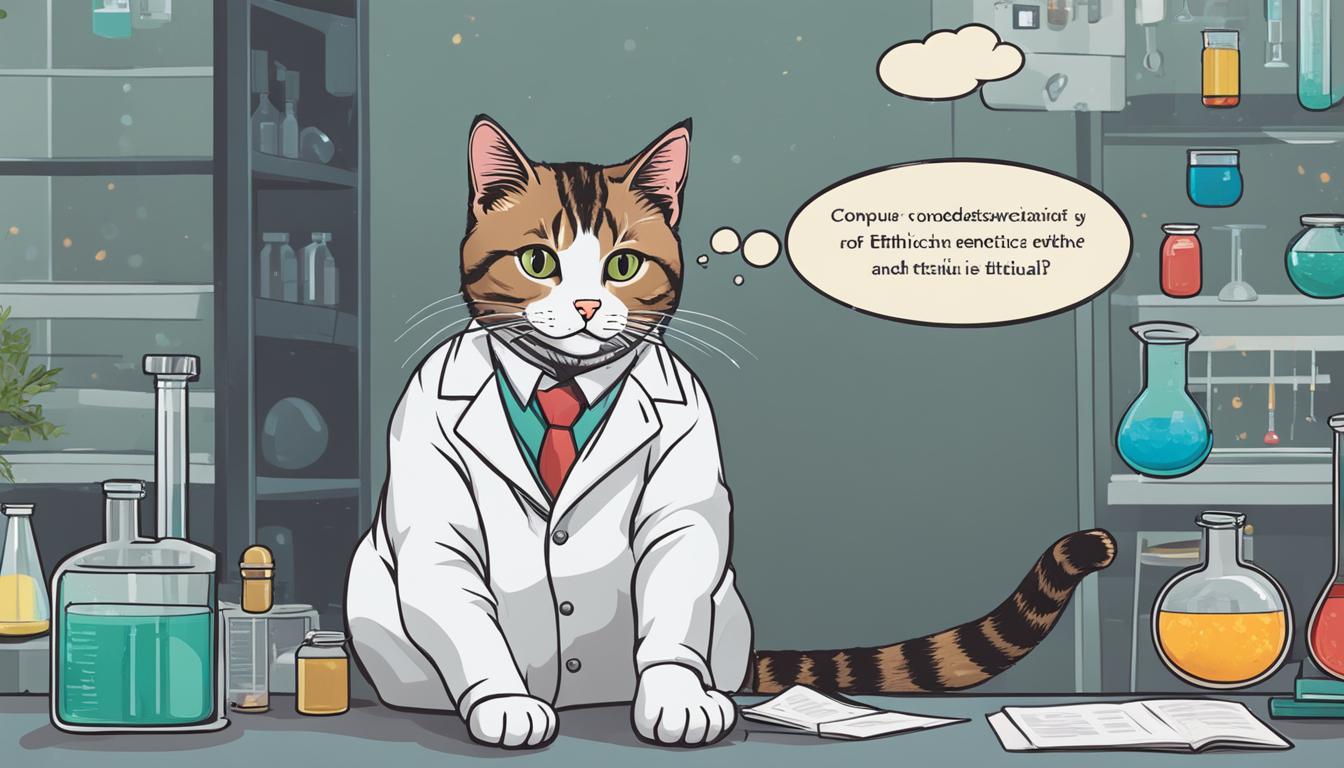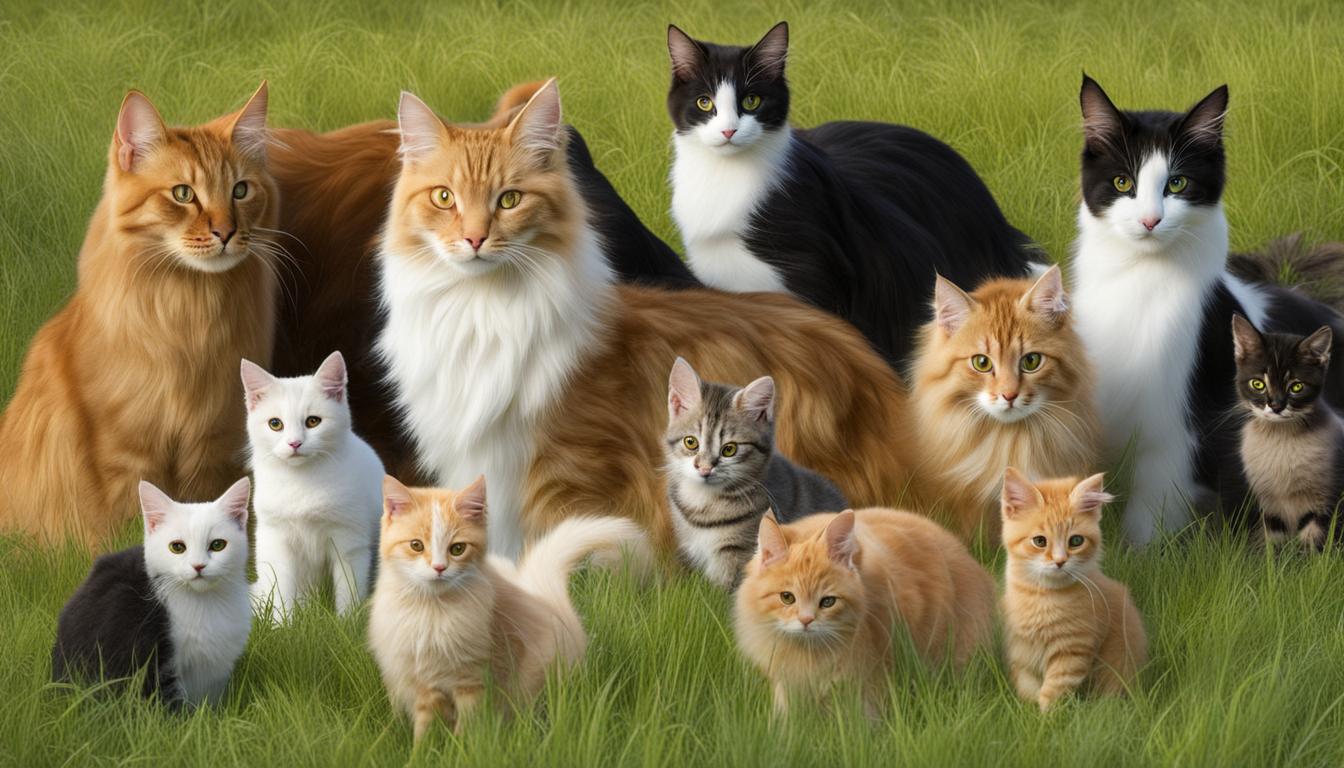Hey there, fellow feline enthusiasts! Today, I’m diving into the fascinating world of wild and domestic cats. Join me as we embark on a journey through their DNA, uncovering the genetic differences that separate our beloved house cats from their untamed counterparts.
But first, let’s take a moment to appreciate the beauty of these majestic creatures. Behold:
Now, let’s get down to business and explore the key takeaways from this comparative DNA analysis:
Key Takeaways:
- Through DNA analysis, clear evidence of genomic divergence between wild and domestic cats has been discovered.
- Genes associated with neurological functions, nutrient metabolism, and coat patterns show significant differences between the two groups.
- Understanding the genetic underpinnings of cat domestication provides valuable insights into the evolution of domestic cat breeds.
- The process of domestication is not fully understood, but genetic studies have shed light on the changes that occurred during this transformation.
- Domestic cats have genetic differences related to reward and pleasure, fear conditioning and memory, which contribute to their distinct characteristics and behaviors.
So, my fellow cat aficionados, buckle up and prepare to be amazed by the hidden secrets that lie within the DNA of our furry friends. It’s time to unravel the genetic tapestry behind the captivating world of wild vs. domestic cats.
The Process of Domestication
The domestication of cats from their ancestor wildcats, specifically Felis silvestris, is a process that is not yet fully understood. The initial domestication of wildcats likely occurred through a self-selective process, driven by behavioral reproductive isolation and habitat choice for urban environments. The study of wild and domestic cat DNA has provided insights into the genetic changes that occurred during domestication. It has been found that domestic cats have undergone genetic selection in genes related to neurological functions, nutrient metabolism, and coat patterns, mirroring their historical roles as domesticated animals.
Genetic studies of wild cat species have revealed that the process of domestication is not limited to changes in physical appearance and behavior. The DNA of domestic cats carries genetic imprints from their wild ancestry, providing clues about their evolutionary journey. Through DNA analysis, scientists have identified specific genetic markers that distinguish domestic cats from their wild relatives. These genetic differences persist in domestic cats due to their historical adaptations to living in close proximity to humans and the selective pressures they experienced.
The genetic changes that occurred during domestication have shaped the traits and behaviors seen in modern-day domestic cats. For example, genes associated with neurological functions, such as those involved in reward and pleasure, have been strongly selected in domestic cats, suggesting a close interaction between humans and cats throughout history. These genetic changes have contributed to the unique bond between cats and humans and their ability to thrive in domestic environments.

Genetic Changes in Coat Patterns
One fascinating aspect of domestication is the genetic changes in coat patterns. Wildcats typically have camouflage fur patterns that help them blend into their natural habitats. In contrast, domestic cats exhibit a wide range of coat patterns, including solid colors, stripes, spots, and tabby patterns. These variations in coat patterns are a result of genetic mutations that occurred during domestication. Genetic studies have identified specific genes associated with coat patterning, such as the tabby gene, that are responsible for the different coat patterns seen in domestic cats.
Evolutionary Insights from DNA Analysis
DNA analysis of wild and domestic cat species provides valuable insights into the evolutionary history of cats and the genetic adaptations that have occurred over thousands of years. By comparing the genomes of wildcats and domestic cats, scientists can trace the genetic changes that have led to the domestication of cats. These genetic studies shed light on the complex process of domestication and offer a glimpse into the genetic diversity and adaptability of cats.
| Genetic Traits | Wildcats | Domestic Cats |
|---|---|---|
| Coat Patterns | Camouflage fur patterns | Wide range of coat patterns |
| Neurological Functions | Genes associated with survival in the wild | Genes associated with interaction with humans |
| Nutrient Metabolism | Optimized for hunting and scavenging | Adapted to domestic diet |
Genetic Differences Between Wild and Domestic Cats
When it comes to analyzing the DNA of big cats versus house cats, fascinating genetic differences come to light. Research comparing the genomes of domestic cats and their wild counterparts has revealed key variations between the two groups. These genetic distinctions shed light on the unique characteristics and behaviors observed in domestic cats.
The analysis shows that domestic cats have undergone genetic selection in genes associated with reward and pleasure, suggesting that their initial domestication may have been fueled by humans appealing to their desire for treats and affectionate interactions. This genetic difference likely contributed to the close bond that has developed between humans and cats over thousands of years.
It’s intriguing to consider that our feline companions may have initially been won over by a simple offering of food and a gentle stroke. These genetic differences in behavior provide valuable insights into the history of cat domestication.
Furthermore, the study reveals genetic differences related to fear conditioning and memory in domestic cats. These traits may have evolved as a response to the positive reinforcement provided by humans, such as being fed and rewarded for certain behaviors. As a result, domestic cats have developed a greater ability to associate actions with rewards, leading to a more trainable and adaptable nature.
Understanding these genetic differences not only enriches our knowledge of cat domestication but also has practical implications for cat owners. It allows us to better comprehend our pets’ instincts and behaviors and provides a foundation for more effective training methods and overall pet care.
| Wild Cats | Domestic Cats |
|---|---|
| Genes related to reward and pleasure | Genes associated with reward and pleasure |
| Genetic differences in fear conditioning and memory | Genetic differences in fear conditioning and memory |
Implications for Cat Owners
As cat owners, it’s important to understand the genetic differences between wild and domestic cats. While domestication has made cats more tolerant of living in human-dominated environments, it has not eliminated their natural predatory instincts. Despite being well-fed, domestic cats still exhibit hunting behaviors, such as killing birds and rodents.
This is because their genetic makeup has been shaped by their historical role as rodent hunters on farms and around homes. In a recent DNA study comparing wild and domestic cat genes, researchers found that domestic cats have genetic differences related to hearing and vision, which contribute to their keen senses and ability to locate prey.
“The study of wild vs. domestic cat DNA sheds light on the fascinating process of cat domestication and the genetic adaptations that have occurred over thousands of years.”
Understanding the genetic basis of these behaviors can help cat owners better understand and manage their pets’ instincts. For example, providing environmental enrichment, such as interactive toys and scratching posts, can help satisfy their natural hunting instincts and prevent them from exhibiting destructive behaviors in the home.
The Importance of Responsible Ownership
Additionally, knowing that domestic cats still possess their innate hunting skills highlights the importance of responsible ownership. It’s crucial to keep cats indoors or provide them with a secure outdoor enclosure to protect native wildlife populations from predation. By taking these measures, cat owners can help preserve the delicate balance of ecosystems and ensure the safety of both their pets and the local wildlife.
In conclusion, the comparative analysis of wild and domestic cat DNA provides valuable insights into the genetic differences and adaptations that have occurred during the process of cat domestication. Understanding these genetic implications is essential for cat owners to better understand their pets’ behaviors and enable them to provide a suitable environment that meets their natural instincts while ensuring the well-being of both the cats and the surrounding ecosystem.
| Wild Cats | Domestic Cats |
|---|---|
| Genetic selection in genes associated with reward and pleasure | Genetic selection in genes associated with neurological functions |
| Genetic differences related to fear conditioning and memory | Genetic differences related to hearing and vision |
| Predatory nature essential for survival | Retained predatory instincts despite domestication |
| Coat patterns for camouflage and thermoregulation | Coat patterns due to breed selection and aesthetic preferences |
Conclusion
Well, my feline-loving friends, after delving into the world of wild and domestic cat DNA, we’ve uncovered some fascinating insights. The genetic differences between our beloved house cats and their wild counterparts are quite intriguing, to say the least.
Through the wonders of scientific analysis, we’ve discovered that our domestic cats have undergone genetic selection in various areas. Genes related to neurological functions, nutrient metabolism, coat patterns, and even behaviors have all been affected by the domestication process.
But here’s the catch, despite centuries of cushy living and being fed delicious meals by their human companions, cats still retain their natural instincts. Those hunting skills that made them excellent rodent catchers haven’t disappeared completely.
So, when Fluffy brings a “gift” to your doorstep or chases a bird around the garden, remember that it’s all in their DNA. These wild cat DNA traits are a reminder of their ancestral heritage and the incredible adaptability that has helped them survive and thrive alongside humans for thousands of years.
FAQ
What is the purpose of the study on wild and domestic cat DNA?
The study aims to understand the genetic differences between wild and domestic cats and shed light on the process of cat domestication.
Which genes were analyzed in the study?
The study focused on genes associated with neurological functions, nutrient metabolism, and coat patterns.
What did the analysis reveal about domestic cats?
The analysis showed that domestic cats have undergone genetic selection in genes related to reward and pleasure, fear conditioning and memory, and hearing and vision.
How did humans initially domesticate cats?
Humans likely domesticated cats by appealing to their desire for treats and stroking, which the genetic analysis suggests.
Do domestic cats still exhibit hunting behaviors?
Yes, despite being well-fed, domestic cats retain their natural predatory instincts and may exhibit hunting behaviors.
Can understanding the genetic basis of cat behavior help cat owners manage their pets’ instincts?
Yes, understanding the genetic basis of cat behavior can help cat owners better understand and manage their pets’ instincts.
What insights does the study provide for cat owners?
The study helps cat owners understand the genetic underpinnings of cat domestication and the evolution of domestic cat breeds.





